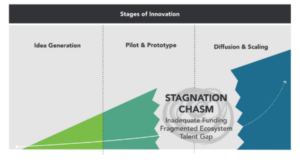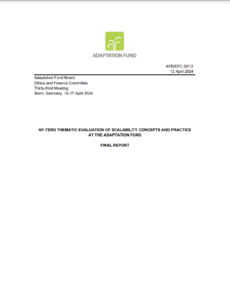Scaling Impact: Evaluating Scalability in the Adaptation Fund’s Portfolio
 The scaling up of adaptation projects, programmes, and ambitions has been widely recognised as essential to tackling the widespread and devastating negative impacts of climate change for communities. The challenge is significant in terms of scale, maybe even unprecedented, hence, small-scale adaptation action is not sufficient. Much remains to be learnt about if and how scaling up is happening in the adaptation context and how best the adaptation funders can provide support.
The scaling up of adaptation projects, programmes, and ambitions has been widely recognised as essential to tackling the widespread and devastating negative impacts of climate change for communities. The challenge is significant in terms of scale, maybe even unprecedented, hence, small-scale adaptation action is not sufficient. Much remains to be learnt about if and how scaling up is happening in the adaptation context and how best the adaptation funders can provide support.
We continue working with the Adaptation Fund and its Technical Evaluation Reference Group (AF-TERG), following the thematic evaluation of AF’s work on innovation, to evaluate scalability within the AF’s portfolio, sharing our insights with the Adaptation Fund and feeding into the ongoing conversations on scaling up and replication within the adaptation space.
Scaling Up – How Does it Happen?
As a broad concept, scaling up lacks a universal definition, but it is often related to ‘piloting’, ‘replication’, ‘uptake’, and ‘diffusion’. Turning small “pebbles in a pond into ripples of change” is a description that we resonate with; in the context of climate adaptation, it is about building on small-scale impact to reach the necessary scale required to address problems associated with climate change.
The process of scaling up is often tied to (social) innovation, a step that follows the successful piloting or trialling of an innovative product, concept, approach etc. The scaling up of innovation can happen in many ways, with three of the most common pathways being via:
- Mainstreaming: bringing innovation from the local level to the national level
- Scaling out (or horizontal scaling): replicating an innovation in a new geographical area
- Applying innovation to a different context or theme

Despite the broad consensus on scaling up climate change and development outcomes, there has been limited academic research on the processes that support (or hinder) the transitioning of a project from a pilot to being scaled up. The research that has been done so far has had a minimal influence on project design, as the problems with scaling up still plague the climate change development sector.
Barriers to Scaling up
Many of us will have been part of a pilot project that, even if successful, was never scaled up due to number of barriers preventing the transition. A key issue is that the process of scaling up is often left to happen spontaneously and not designed into the pilot, and as a result there is a lack of forward planning. Other barriers to scaling up pilot projects include:
- Reliance on external resources (funding and project management personnel)
- Fixed time horizons (little room for flexible management and unplanned learning)
- Pilot projects often operate in a vacuum (shielded from politics, markets and other external factors that would affect their functioning, suitability and long-term sustainability) (Woltering et al., 2019)
Despite these barriers, there is increasing recognition of the need to design projects with scale in mind, as well as recognition of the strong links between (social) innovation and scaling up. As such, several development actors have published guidance documents (GCF, Scaling Framework – IFAD), created tools and resources (Scaling Playbook – IDRC, Scaling up: How to get a Good Idea Up and Running – GIZ) and even published books (Scaling Impact – IDRC) to practically shape and support the scaling up of adaptation.
Scalability of Adaptation Fund Projects
With the worsening impacts of climate change over recent years, finance for climate adaptation has become an important focus. Within this landscape, the Adaptation Fund has become a key player in the provision and distribution of global adaptation finance while also occupying an important role in the wider adaptation community.
 The Fund’s activities are designed to build national and local adaptive capacities while reaching and engaging the most vulnerable groups and integrating gender consideration to provide equal opportunity to access and benefit from the Fund’s resources. They also aim to enhance synergies with other sources of climate finance while creating models for adaptation that can be replicated or scaled up.
The Fund’s activities are designed to build national and local adaptive capacities while reaching and engaging the most vulnerable groups and integrating gender consideration to provide equal opportunity to access and benefit from the Fund’s resources. They also aim to enhance synergies with other sources of climate finance while creating models for adaptation that can be replicated or scaled up.
With the global re-focusing on climate adaptation brought about by the recent IPCC Working Group 2 report and the rising number and intensity of climate-induced humanitarian disasters over the past few years, scaling up adaptation must be a global priority.
The collaboration with the AF-TERG and other stakeholders of the Adaptation Fund (AF), such as the Secretariat, has culminated in a report that summarizes and assesses the AF’s work and instruments that enable scaling (see also the related official AF Board document) to enable successful and effective climate adaptation.
